From Bulk to Structural Failure: Fracture of Hyperelastic Materials 3658316047, 9783658316044
This thesis investigates the fracture of nearly incompressible hyperelastic media. It covers the different characteristi
239 89 9MB
English Pages 204 [214] Year 2021
Table of contents :
Preface
Abstract
Kurzfassung
Table of contents
Nomenclature
1 Introduction
1.1 Motivation
1.2 State of the art
1.3 Objectives and structure
2 Theoretical background
2.1 Fundamentals of continuum mechanics
2.1.1 Kinematics
2.1.2 Stress
2.1.3 Balance principles
2.1.4 Hyperelasticity
2.2 Bulk material failure
2.3 Fracture mechanics
2.4 Finite fracture mechanics
3 Samples and finite element models
3.1 Unnotched specimens
3.1.1 Dumbbell specimens
3.1.2 Bulge specimens
3.1.3 Uniaxial compression specimens
3.1.4 Tubular lap shear specimens
3.2 Notched specimens
3.2.1 H-shaped specimens
3.2.2 Notched tubular lap joints
3.2.3 Pancake specimens
3.2.4 Cleavage double cantilever beam specimens
3.2.5 Out-of-plane shear double cantilever beam specimens
4 Experimental material characterization
4.1 State of the art
4.2 Characterization of the constitutive behavior
4.3 Bulk material extensibility
4.4 Fracture toughness
4.4.1 Cleavage tests
4.4.2 Out-of-plane shear tests
5 Bulk material failure
5.1 State of the art
5.2 Generalized deviatoric function
5.3 Equivalent strain failure criterion for hyperelastic media
5.4 Combined distortional–dilatational failure mode concept
6 Nucleation of finite cracks in hyperelastic materials
6.1 State of the art
6.2 Mixed-mode crack nucleation criterion
6.3 Failure prediction
6.3.1 Simple shear test
6.3.2 Pull-off and tubular shear tests
6.3.3 Pancake test
6.3.4 Discussion
6.4 Crack nucleation, crack growth and crack arrest
6.5 Derivation of a simple design tool
7 Hyperelastic weak interface model
7.1 State of the art
7.2 Sandwich-type model for nonlinear elastic adhesives
7.3 Stress and strain analysis
7.4 Failure prediction
8 Conclusions and perspectives
References
Preface
Abstract
Kurzfassung
Table of contents
Nomenclature
1 Introduction
1.1 Motivation
1.2 State of the art
1.3 Objectives and structure
2 Theoretical background
2.1 Fundamentals of continuum mechanics
2.1.1 Kinematics
2.1.2 Stress
2.1.3 Balance principles
2.1.4 Hyperelasticity
2.2 Bulk material failure
2.3 Fracture mechanics
2.4 Finite fracture mechanics
3 Samples and finite element models
3.1 Unnotched specimens
3.1.1 Dumbbell specimens
3.1.2 Bulge specimens
3.1.3 Uniaxial compression specimens
3.1.4 Tubular lap shear specimens
3.2 Notched specimens
3.2.1 H-shaped specimens
3.2.2 Notched tubular lap joints
3.2.3 Pancake specimens
3.2.4 Cleavage double cantilever beam specimens
3.2.5 Out-of-plane shear double cantilever beam specimens
4 Experimental material characterization
4.1 State of the art
4.2 Characterization of the constitutive behavior
4.3 Bulk material extensibility
4.4 Fracture toughness
4.4.1 Cleavage tests
4.4.2 Out-of-plane shear tests
5 Bulk material failure
5.1 State of the art
5.2 Generalized deviatoric function
5.3 Equivalent strain failure criterion for hyperelastic media
5.4 Combined distortional–dilatational failure mode concept
6 Nucleation of finite cracks in hyperelastic materials
6.1 State of the art
6.2 Mixed-mode crack nucleation criterion
6.3 Failure prediction
6.3.1 Simple shear test
6.3.2 Pull-off and tubular shear tests
6.3.3 Pancake test
6.3.4 Discussion
6.4 Crack nucleation, crack growth and crack arrest
6.5 Derivation of a simple design tool
7 Hyperelastic weak interface model
7.1 State of the art
7.2 Sandwich-type model for nonlinear elastic adhesives
7.3 Stress and strain analysis
7.4 Failure prediction
8 Conclusions and perspectives
References

- Author / Uploaded
- Philipp Laurens Rosendahl
![From Bulk to Structural Failure: Fracture of Hyperelastic Materials [1st ed.]
9783658316044, 9783658316051](https://ebin.pub/img/200x200/from-bulk-to-structural-failure-fracture-of-hyperelastic-materials-1st-ed-9783658316044-9783658316051.jpg)








